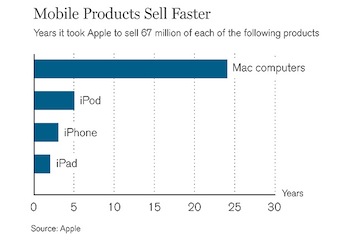We have talked about this before but more facts have come to light regarding the explosion of mobile data traffic, signaling a substantive change in how the world accesses information. In the Rise of mobile and the death of the rest the focus was on the business risks and opportunities coming from the rise of mobile computing.
Just yesterday, in an article in MIT’s Technology Review there was even more evidence of the rise of mobile. The article, titled Four Charts That Illustrate the Transformation of Personal Computing was a summation of a Mary Meeker of KPCB presentation on the state of the internet (slide share embedded above).
The MIT article had one chart (see slide 15 above in Mary’s deck) that showed mobile internet traffic in November 2012 was 13% of all internet traffic which grew from a base level of ~1% in Dec 2009. So in roughly 3 years, mobile traffic is consuming over 13X more internet bandwidth than any other type of device.
Just in case you needed more convincing, in another article in MIT Technical Review (this one on spectrum sharing) Cisco was quoted as saying that mobile traffic would grow 18X by 2016.
If mobile’s winning, who’s losing?
That has got to be desktop computing. In fact, another chart (slide 16 in Mary’s deck) showed a comparison of India’s internet traffic tracking desktop vs mobile devices, from December 2008 to November 2012. In this chart India’s mobile internet exceeded desktop traffic sometime the middle of this year.
But I think the one chart that tells this better (see one slide 25) shows that smartphones and tablets shipments exceeded desktops and laptops in 2010. The other interesting thing is that one can also see the gradual decline in desktops and laptop shipments since then.
Where’s the revenue streams?
The funny thing about Mary’s presentation is the fact that she was tracking mobile app and mobile advertising (see slide 17) as a rising revenue opportunity, expected to reach $19B in 2012. In my post on the rise of Mobile, I assumed that mobile advertising would not be a successful model for mobile revenue streams – I was wrong.
Mary’s presentation also showed some of the impact of mobile on other markets and foretells the future impacts mobile will have. One telling example for this is standalone camera sales vs mobile camera shipments (see slide 32) which crossed over in 2008 where standalone camera sales peaked at~150M units. The same thing happened with standalone personal navigation devices (PND) (see slide 34) that peaked 13M units in 2009 but where Waze unit (mobile navigation aid) exceeded PND unit shipments in Q1 2012.
The remainder of the presentation (at least what I read) seemed to define a new life-style option she called Asset-Light which was all about shedding physical assets like wallets, paperback books, TV and other screens, fixed LAN connectivity and moving to a completely mobile world where everything you need is on your tablet with access to the internet via WiFi or LTE.
Mobile is here, better get ready and figure out how to do business with it or consider this a great time to curtail your growth prospects.
Comments
